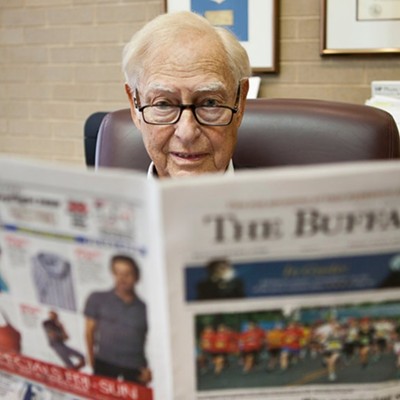ARIZONA ILLUSTRATED HAS NEW ARTS HOST
PBS affiliate Arizona Public Media has named Debi Chess Mabie as host of its Thursday Arizona Illustrated Arts program. Before moving to the Old Pueblo in 2010 and taking a job with the Tucson Pima Arts Council, Mabie was executive director of the Boocoo Cultural Center and Café in Evanston, Ill.
She has a bachelor's in social work from Wright State and a master's in urban planning and policy from the University of Illinois at Chicago.
Arizona Illustrated, which airs at 6:30 p.m. weekdays on KUAT Channel 6, is divided into five themed shows each week.
Also at AZPM, reporter Fernanda Echavarri is one of 20 recipients of The Changing Face of America: Immigration and the Politics of Reform fellowship at the University of California, Berkeley's Graduate School of Journalism. The New York Times sponsors the fellowship.
Echavarri covers immigration, other border-related topics, education and public affairs for AZPM.
WWE TRIES CARVING NEW VIEWING NICHE
There's a dirty little secret in the history of television: the importance of professional wrestling to the medium's success in its early days. When local television stations searched for programming to fill all the air time suddenly available, they discovered that viewers across the country flocked to pro wrestling and its stable of heroes and villains.
This was the golden era for such programming, when Grandpa would watch the TV in his underwear and yell at the parade of heels entering an exiting the ring. As the decades passed and other shlock fare, such as roller derby, peaked and eventually disappeared, professional wrestling somehow survived. And often flourished.
After thriving in the antenna-only era, wrestling increased its impact in the early days of cable, with new fans introduced to new faces. You could now live in Arizona and watch announcer Gordon Solie outline the treachery or purity of performers such as Tommy Rich, Harley Race, Austin Idol, Ric Flair and the Four Horsemen as Georgia Championship Wrestling broadcast matches from the Omni in Atlanta.
Cable gave you access to the Von Erichs in Texas, to the NWA and WWF. As television choices increased, wrestling maintained its place for many stations as crucial programming fare.
Professional wrestling was a forerunner in closed circuit and had found its life's blood in pay per view. And ever since the WWE's (formerly the WWF's) flagship program, RAW, launched more than 20 years ago, it has been at or near the top of cable's weekly ratings.
The sophisticates don't get it. They brush it off as American hickdom and act as though it doesn't exist, yet professional wrestling has been consistently crucial to the advancement of the industry.
And as it moves past the controversial remnants of last weekend's 30th Wrestlemania, the WWE is embarking on what it hopes is the future of how we watch TV. In the process, it is banking on the increasing trend of cord-cutting to continue solid viewership while not being beholden to the ever-increasing contractual disputes of traditional television.
Six weeks ago, the WWE launched its own network app. And if you're a wrestling fan, it's a smokin' deal: Ten bucks a month, with a six-month sign-up requirement, gets you access to a growing portion of the company's vast wrestling library, including major television programs, first-run in-house-produced series and pay-per-views. So viewers could watch Sunday's Wrestlemania for the $10-a-month fee as opposed to forking over six to seven times that for the stand-alone four-hour event.
Mixed martial arts organization UFC has tried something like this as well, but it doesn't offer the pay-per-views as part of its package. The WWE hopes it can lure enough viewers to make up for dwindling PPV numbers while controlling its own content and keeping as much of its earnings as possible.
But the move also illustrates the transitional nature of the medium. The company's stock plummeted nearly 20 percent Monday when WWE announced its network app has 667,000 subscribers. That may sound like a pretty good number but it's well below what WWE garners through weekly television viewing.
Some analysts believe the WWE needs at least twice the number of current subscribers to make the app network financially viable. And this is for an organization that has compiled decades of material and produces original programming at an astounding rate. Based on its built-in advantages, this is about as good as a singular network app is going to get.
While there aren't that many entertainment outlets that can pull this off, other networks and television companies are watching closely. CBS, for example, has suggested it is considering models that better control its revenue stream. But if the WWE can't make the concept work, that suggests the industry isn't ready or able to completely cut the cord. This a la carte approach to content control through apps may complement television, as opposed to being a stand-alone option.
LEE TOP BRASS LIVE THE HIGH LIFE AGAIN
Citing "successful completion of long-term financing," Lee Enterprises has awarded CEO Mary Junck and CFO Carl Schmidt six-figure thank you bonuses. Junck received 700K while Schmidt recently cashed a 400K check from the company.
So what's Lee's definition of solid financial improvement? Well, even though it continues to lose money, it did manage to push back maturities of 800 million dollars worth of debt to 2019 and 2022. Granted, the interest rates are higher too, but at least Lee might not default by the turn of the decade now.
Since news of that refinancing package was announced late last month, Lee stock has lost about 20 percent of its value. At its peak earlier this year, Lee traded at 5.89. It hovered in the 4.35 range as of Monday.






